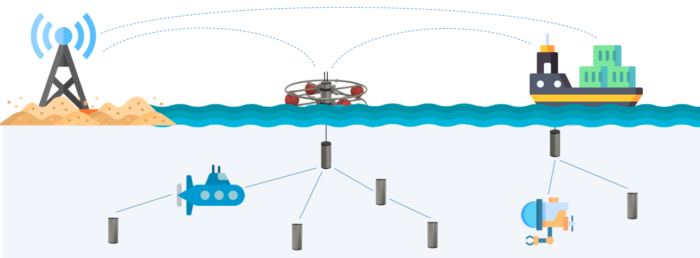Sara Falleni
Ph.D. Student

Adaptable, reliable, and extended underwater networks of the future will rely on underwater acoustic wireless modems (grey tubes in the figure) to perform continuous data collection and exchange among static and mobile nodes. Real-time data access will enable a variety of tasks like ocean monitoring and disaster prevention. The figure represents a scenario in which underwater acoustic modems (grey tubes) rely data among different types of nodes: smart buoys on the surface, submarines, static nodes that collect information on the bottom of the ocean, and remotely operated vehicles.
The oceans and other earth waterways are fundamental for human welfare and survival. To better understand the complex systems of the underwater world and promote its sustainable exploitation, researchers at WIoT Institute have recognized the urgency of advancing the Internet of Underwater Things. “A Reservation-based Adaptive MAC Protocol for OFDM Physical Layers in Underwater Networks” is one of the most recent in a series of works by WIoT researchers intended to test the limits of solutions for underwater networking.
This work presents a Reservation-based Adaptive MAC (RAMAC) protocol that leverages OFDM’s capabilities. RAMAC is tested through DESERT-based simulations based on the design of real OFDM-enabled underwater acoustic modems developed at WIoT. RAMAC demonstrates robust data delivery and latency control, even in the presence of external interference.
This research drives underwater connectivity and data transmission progress for the “Blue Economy.”
Source: ieee.org
Ph.D. Student
WIoT Institute Director
William Lincoln Smith Professor of Electrical and Computer Engineering
Professor of Electrical and Computer Engineering